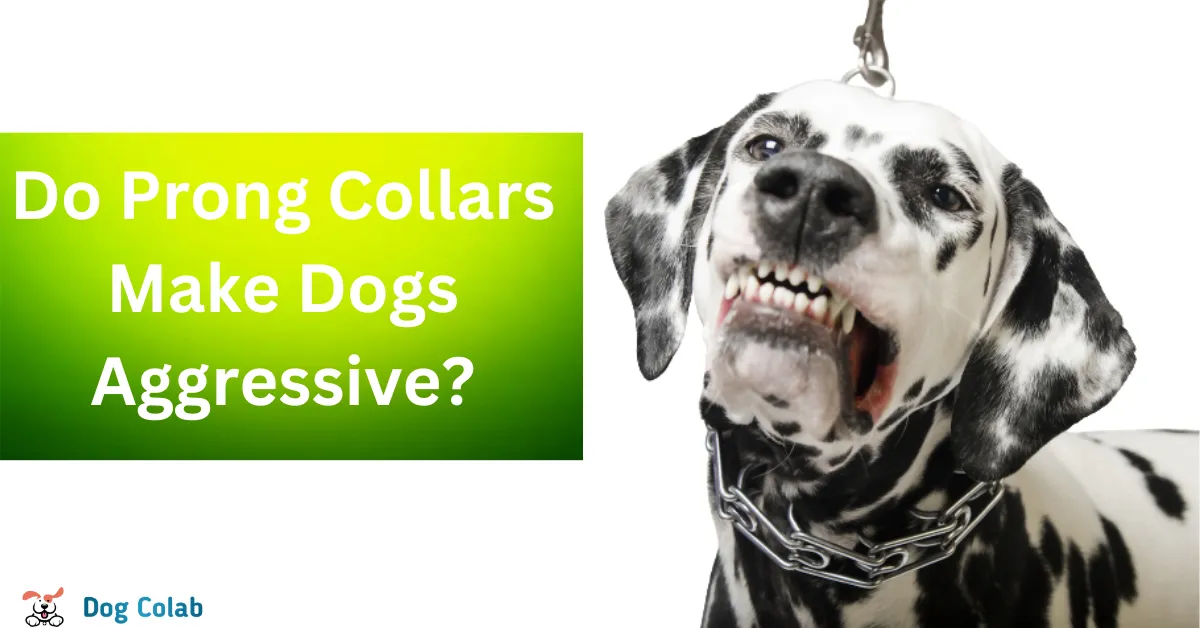Dog prong collars have been the subject of a long-standing debate regarding whether can a prong collars make dogs aggressive. Some people argue that prong collars are effective training tools, while others argue that they are cruel and can harm them. There have been studies proving that prong collars can damage dogs’ skin and puncture wounds.
Further behavioral issues can arise when dogs wear prong collars, including fear and aggression. Prong collars continue to be used as training tools by some dog trainers despite these potential risks. In this blog post, we will discuss do prong collars make dogs aggressive and alternative methods of training that are just as effective.
What Is a Prong Collar For Dogs?
A prong collar for dogs, also known as a pinch collar, is a training tool designed to provide feedback and control during walks and training sessions. It consists of a metal chain with evenly spaced prongs that face inward toward the dog’s neck.
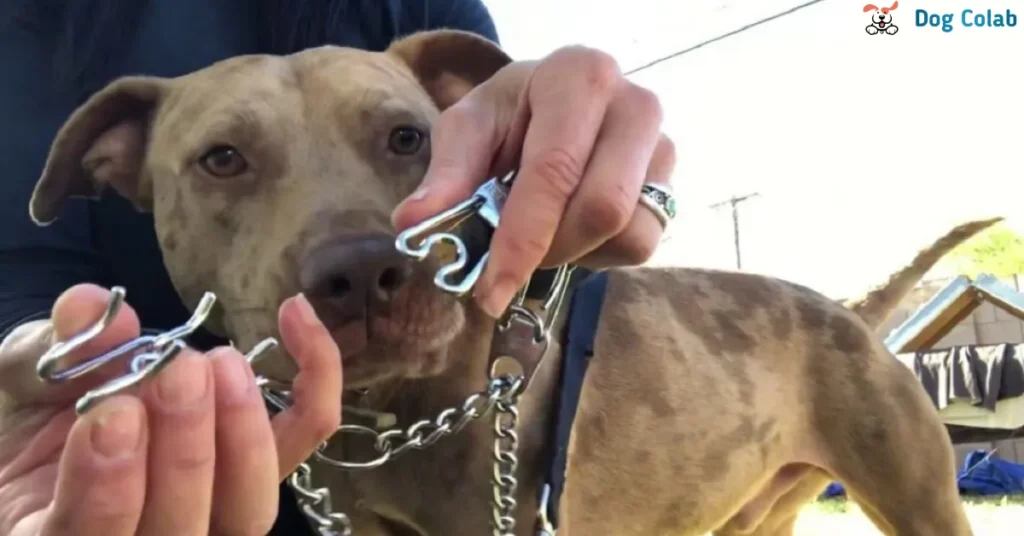
When the dog pulls on the leash or exhibits unwanted behavior, the prongs create a pinching sensation on the neck, which is intended to mimic the corrective action.
The intended purpose of a prong collar is to provide clear communication between the handler and the dog, discouraging pulling, lunging, and other undesirable behaviors while walking on a leash.
Recommended Also Read:- What is the static stimulation dog collar.
Do Prong Collars Make Dogs Aggressive?
The question of whether do prong collars cause aggression is a complex and debated topic. There isn’t a definitive answer, as the relationship between prong collars and aggression is influenced by various factors, including the dog’s individual temperament, the training methods used, the handler’s skill, and the context in which the collar is employed.
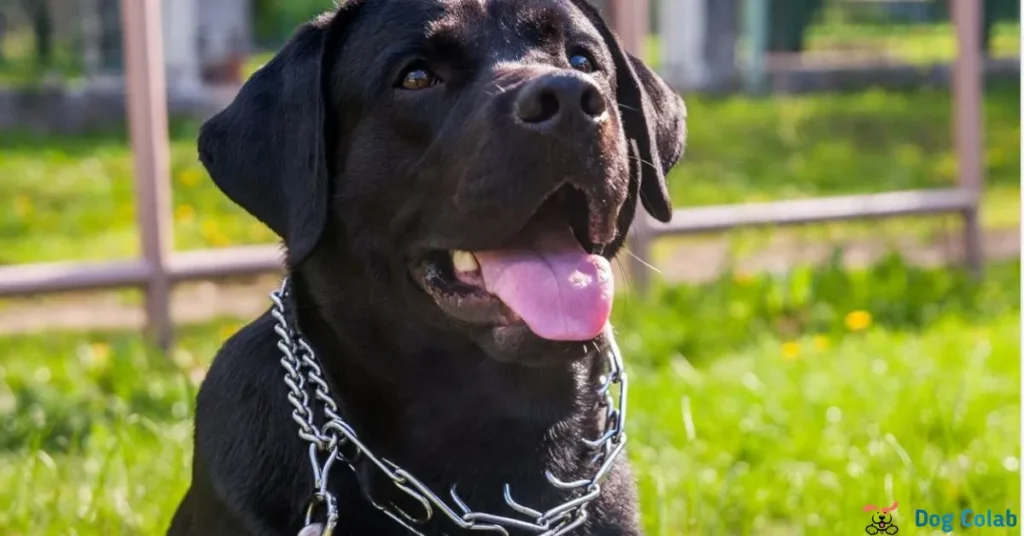
Understanding the Concerns
Critics of prong collars often express concerns that the discomfort or pain caused by the prong collar’s prongs could lead to increased aggression in dogs. The argument is that a dog may associate the discomfort with certain situations, people, or dogs, potentially leading to reactive or aggressive behaviors as a defensive response.
Scientific Studies
There is limited scientific research specifically addressing the link between prong collars and aggression in dogs. One study, conducted by Herron, Shofer, and Reisner in 2009, examined various training methods, including those involving aversive techniques like prong collars. The study’s results suggested a correlation between the use of confrontational training methods and the occurrence of undesirable behaviors in dogs.
This included methods such as prong collars, choke chains, and electronic collars. The researchers found that dogs subjected to these methods were more likely to exhibit aggressive behaviors toward family members and strangers while the study did not establish causation.
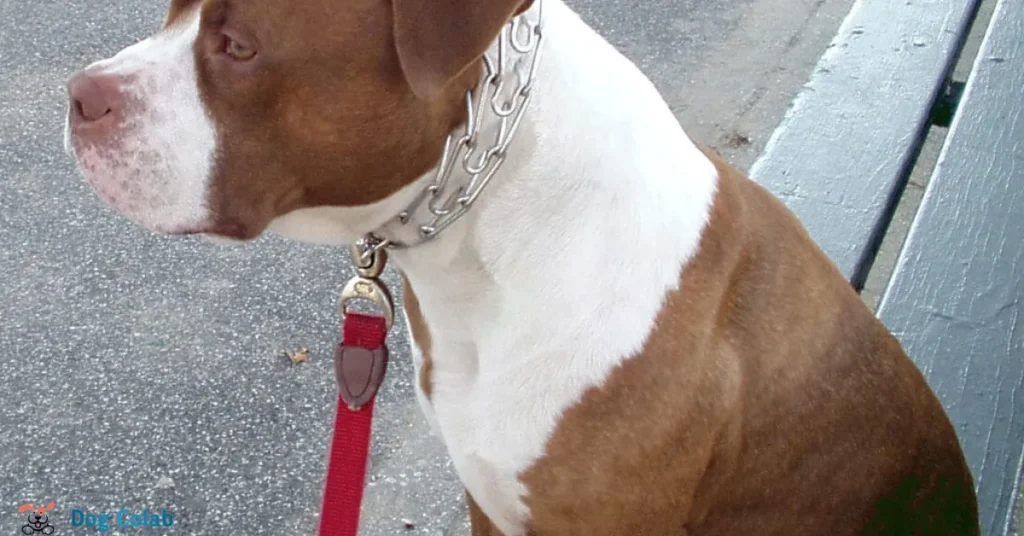
Another study by Rooney and Cowan (2011) revealed a significant relationship between the use of punitive training methods, including prong collars, and problematic behaviors in dogs. Specifically, dogs that were trained using punitive methods were more likely to exhibit fear-related behaviors and aggression towards both family members and unfamiliar individuals.
Moreover, the study found that owners using punitive methods were less likely to recognize signs of stress or aggression in their dogs, potentially indicating a lack of understanding about the negative consequences of these techniques.
However, both Herron et al. (2009) and Rooney and Cowan (2011) studies provide valuable insights into the potential relationship between the use of prong collars and aggressive behaviors in dogs. While these studies do not definitively establish a causal link, they do suggest an association between aversive training methods, including prong collars, and an increased likelihood of aggressive behavior and fear-related issues in dogs.
Proper Application and Training
Whether can a prong collars make dogs aggressive largely depends on how it is used. If a prong collar is used improperly, such as using excessive force or causing undue pain, it could potentially lead to fear, anxiety, and aggression in the dog.

On the other hand, when used correctly by a skilled and knowledgeable trainer, a prong collar may provide clear communication and guidance to the dog without causing harm.
Individual Factors
It’s important to recognize that each dog is an individual with a unique temperament and response to training methods. Some dogs may be more resilient and less affected by the discomfort of a prong collar, while others may become anxious, fearful, or reactive.
Factors such as breed, history, socialization, and the dog’s overall stress threshold can all play a role in determining the impact of a prong collar on a dog’s behavior.
Read More:- Get rid of dog collar marks.
What Are Prong Collars Used For?
Prong collars, also known as pinch collars, are primarily used as training tools for dogs to address issues related to leash pulling and improve control during walks. They are designed to provide feedback to the dog when it pulls on the leash or displays unwanted behaviors.

Here are some common uses of prong collars.
- Leash Pulling: Prong collars are often used to discourage dogs from pulling excessively on the leash during walks. The prongs create a pinching sensation on the dog’s neck when it pulls, serving as a corrective measure to communicate that pulling is undesirable.
- Obedience Training: Prong collars can be employed as part of obedience training to teach commands such as “heel” and “sit.” The collar’s design allows for quick and direct communication between the handler and the dog, making it easier to convey desired behaviors.
- Focus and Attention: For dogs that become easily distracted or exhibit hyperactivity during walks, prong collars may help maintain the dog’s focus on the handler. The discomfort from the collar’s prongs can redirect the dog’s attention back to the handler’s cues.
- Behavioral Modification: Prong collars can be used in behavior modification programs to address specific issues such as lunging, barking, or jumping. When combined with positive reinforcement techniques, the collar can help shape more appropriate behavior.
- Control and Safety: Prong collars may provide better control over strong, large, or energetic dogs, particularly in situations where safety is paramount, such as around traffic or other animals.
Read more:- Best materials for dog collars.
Are Prong Collars Safe For Dogs?
Some trainers and dog owners believe that prong collars can be used safely and effectively when properly applied, others raise concerns about their potential risks and the potential for misuse.
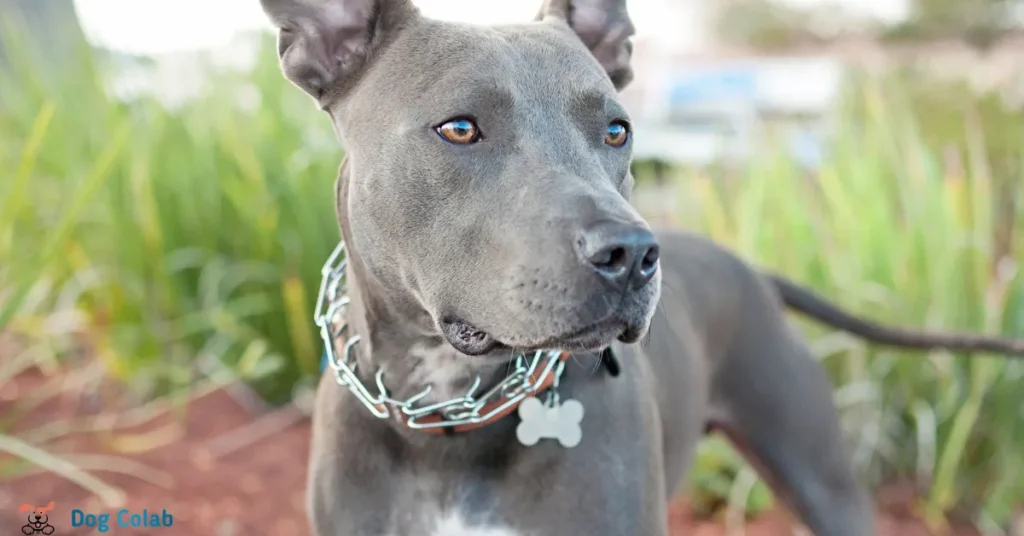
Here’s a balanced overview of the safety considerations surrounding prong collars.
1. Proper Application
The safety of prong collars largely depends on their proper application and the knowledge of the handler using them. When used by experienced trainers who understand canine behavior and have received proper instruction on how to use prong collars, the risk of injury or harm to the dog is minimized.
2. Injury Risk
Improper use of prong collars can lead to injuries. If the collar is fitted too tightly or applied incorrectly, it can cause abrasions, irritation, and even cuts to the dog’s neck. Additionally, excessive or harsh corrections can cause discomfort and distress to the dog, potentially leading to behavioral issues.
3. Negative Association
If not used carefully, prong collars have the potential to create negative associations for the dog. This can lead to increased fear or anxiety during walks or training sessions, which can negatively impact the dog’s overall well-being and behavior.
4. Individual Sensitivity
Not all dogs react the same way to prong collars. Some dogs may be more sensitive to the discomfort caused by the prongs, leading to stress, fear, or avoidance behaviors. Understanding the individual dog’s temperament and sensitivity is crucial when deciding whether a prong collar is an appropriate tool to use.
Do Vets Recommend Prong Collars?
Opinions among veterinarians regarding the use of prong collars for dogs vary. While some veterinarians may acknowledge that prong collars can be used effectively when properly applied by experienced trainers but many veterinarians have concerns about their potential risks and prefer to recommend alternative training methods that prioritize the dog’s safety and well-being.

If you are considering using a prong collar for your dog, it’s advisable to consult with a veterinarian or a veterinary behaviorist to discuss your dog’s individual needs and behavior.
They can provide personalized advice and guidance based on your dog’s temperament and training goals. If a prong collar is recommended, it can help ensure that it is used safely and appropriately to minimize the potential for harm.
You might also want to know about:- Are thicker collars better for dogs.
At What Age Can You Use a Prong Collar on a Puppy?
Using a prong collar on a puppy requires careful consideration, as puppies are still developing physically and emotionally. Prong collars are generally not recommended for very young puppies or those under six months of age, as their necks are more delicate and susceptible to potential harm. Puppies also tend to be more sensitive and impressionable, which means that their early experiences can have a significant impact on their future behavior and temperament.

Instead of using a prong collar on a young puppy, it’s advisable to focus on positive reinforcement-based training methods that build a strong foundation of trust and obedience. These methods can help your puppy learn desired behaviors and manners without the risk of causing discomfort or harm.
If you’re considering using a prong collar on an older puppy (typically around six months of age or older), it’s essential to consult with a professional dog trainer or a veterinarian with expertise in behavior and training.
Recommended Also Read:- How does a puppy get used to a collar.
How To Use a Prong Collar Correctly?
Using a prong collar correctly requires careful understanding, proper fitting, and responsible handling. If you’re considering using a prong collar for your dog, follow these guidelines to ensure its proper and safe usage.
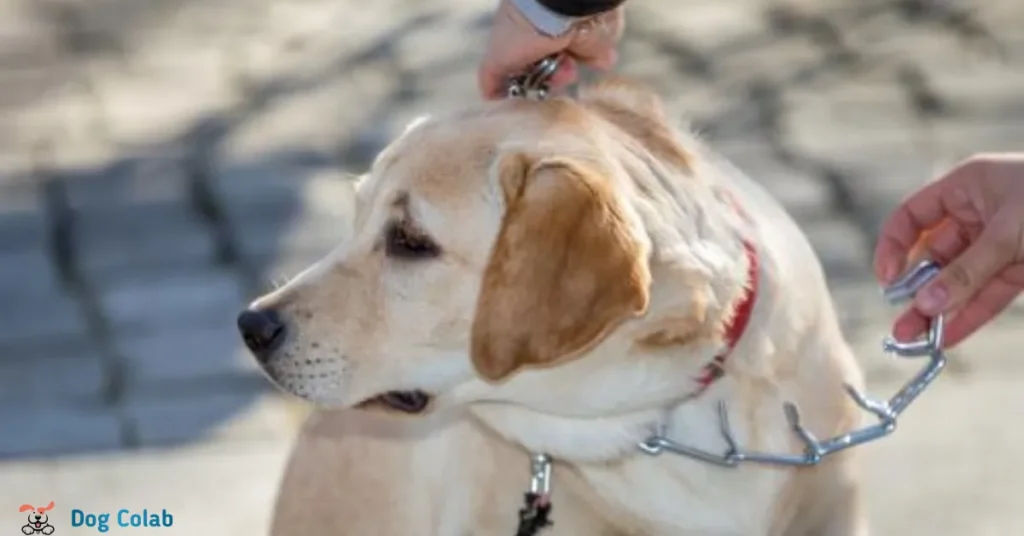
- Choose the Right Size: Prong collars come in different sizes with various numbers of prong links. Making sure your dog’s collar fits properly is important. The collar should be snug enough to stay in place, but not so tight that it causes discomfort or injury. You should be able to fit two fingers between the collar and your dog’s neck.
- Proper Positioning: Place the prong collar high on your dog’s neck, just behind the ears and under the jaw. This ensures that the collar’s correction is more effective and less likely to cause injury compared to placing it lower on the neck.
- Proper Use of Leash: Attach the leash to both the live ring (located on the opposite side of the prongs) and the dead ring (where the leash attaches to the collar). This setup allows for better control and communication.
- Use Gentle Pressure: The prong collar should be used with gentle pressure, not sharp or forceful jerks. The idea is to create a noticeable but not painful sensation when the dog pulls or misbehaves.
- Combine with Positive Reinforcement: Combine prong collar use with positive reinforcement. Reward your dog for good behavior and provide treats, praise, or toys when they respond correctly to your commands.
- Limit Use: Prong collars should not be used continuously. They should be used as a training tool for specific behavior modifications and not as an everyday collars.
- Regular Checks: Regularly inspect your dog’s neck for any signs of discomfort, irritation, or skin issues. Ensure that the prongs are not causing undue pressure or digging into the skin.
- Monitor Behavior: If you notice any signs of distress, fear, or discomfort in your dog while using the prong collar, discontinue its use immediately and consult with a professional.
Alternatives To Prong Collars
There are several positive and effective alternatives to prong collars that prioritize your dog’s well-being and focus on building a strong bond between you and your furry companion. Here are some alternatives to consider.

- Flat Collars and Harnesses: Traditional flat collars or harnesses are gentle options for walking and training. They distribute pressure evenly across the dog’s neck or body, reducing the risk of injury.
- Front-Clip Harnesses: Front-clip harnesses attach the leash at the front of the dog’s chest, encouraging them to walk beside you and reducing pulling. They provide control without causing discomfort.
- Head Halters: Head halters, like the Gentle Leader or Halti, fit around the dog’s muzzle and behind the ears. They offer control by gently redirecting the dog’s head and focus.
- Martingale Collars: These collars are designed to prevent dogs from slipping out of them. They tighten slightly when the dog pulls, discouraging dog pulling while remaining gentler than prong collars.
- Positive Reinforcement Training: Positive reinforcement techniques involve rewarding your dog for desired behaviors. Use treats, toys, praise, and clickers to reinforce good behavior and discourage undesirable actions.
- Clicker Training: Clicker training is a positive reinforcement method that uses a clicker to mark desired behaviors, followed by a reward. This method can be effective in shaping behaviors without the need for aversive tools.
- Target Training: Teach your dog to touch a specific target (like your hand or a target stick) with their nose or paw. This can be used to guide them into desired positions.
Remember, training takes time, patience, and consistency. Positive reinforcement methods not only create a more enjoyable experience for both you and your dog but also contribute to building a trusting and respectful relationship.
You may also be interested in:– How many collars should a dog have.
Conclusion “Do Prong Collars Make Dogs Aggressive”
The question of whether do prong collars cause aggression does not have a straightforward answer but it’s essential to approach their use with caution. Prong collars, when used improperly or excessively, have the potential to create negative associations, stress, and even fear in dogs. Responsible training techniques, emphasizing positive reinforcement and proper communication, are key to fostering a harmonious relationship and achieving desired behavior changes without resorting to potentially harmful tools.
Recommended reading for further exploration of the topic.
FAQs
1. What are the disadvantages of prong collars?
Prong collars can cause pain, discomfort, and potential injury to dogs, and may reinforce negative behaviors. Improper use can harm the human-animal bond and lead to aggression or fear.
2. When should you not use a prong collar?
Avoid using a prong collar for dogs with aggression issues. Prong collars can escalate aggression or cause fear, making alternative training methods safer and more appropriate.
3. Can I use prong collar everyday?
Using a prong collar every day can be harmful to your dog’s physical and emotional well-being. It’s important to explore positive training methods and consult a professional dog trainer.
4. What is the difference between a prong collar and a pinch collar?
A prong collar and a pinch collar are the same. An alternative is the Wiotar Dog Prong Collar, which offers similar training benefits and quick-release convenience.
5. Are prong collars better than choke collars?
Prong collars, designed to minimize harm compared to choke collars, offer uniform pressure when unsharpened. Both types use discomfort for training.
